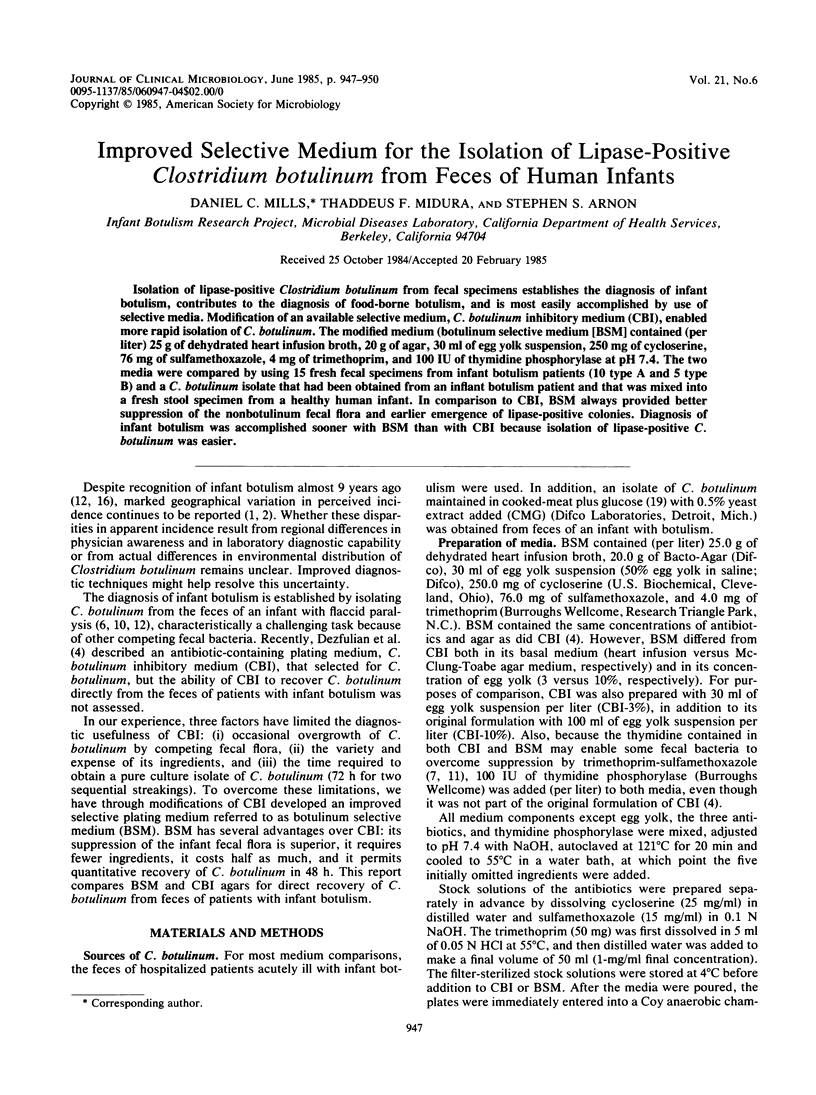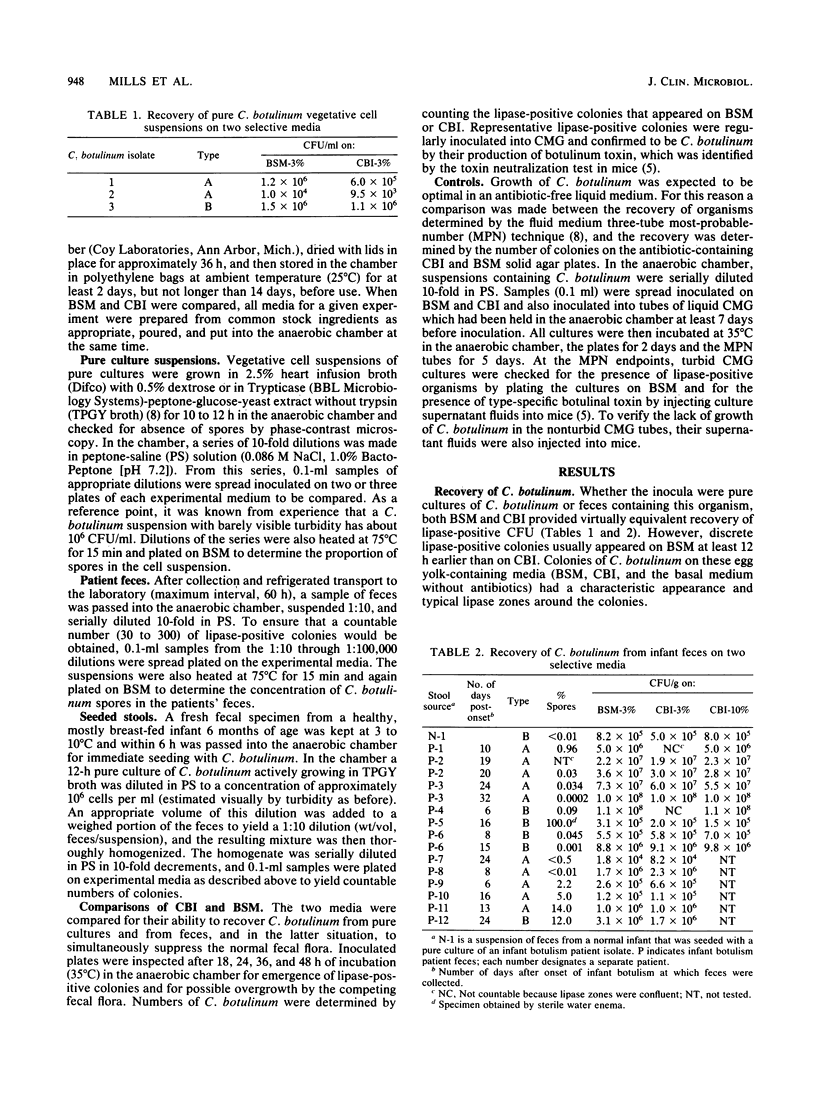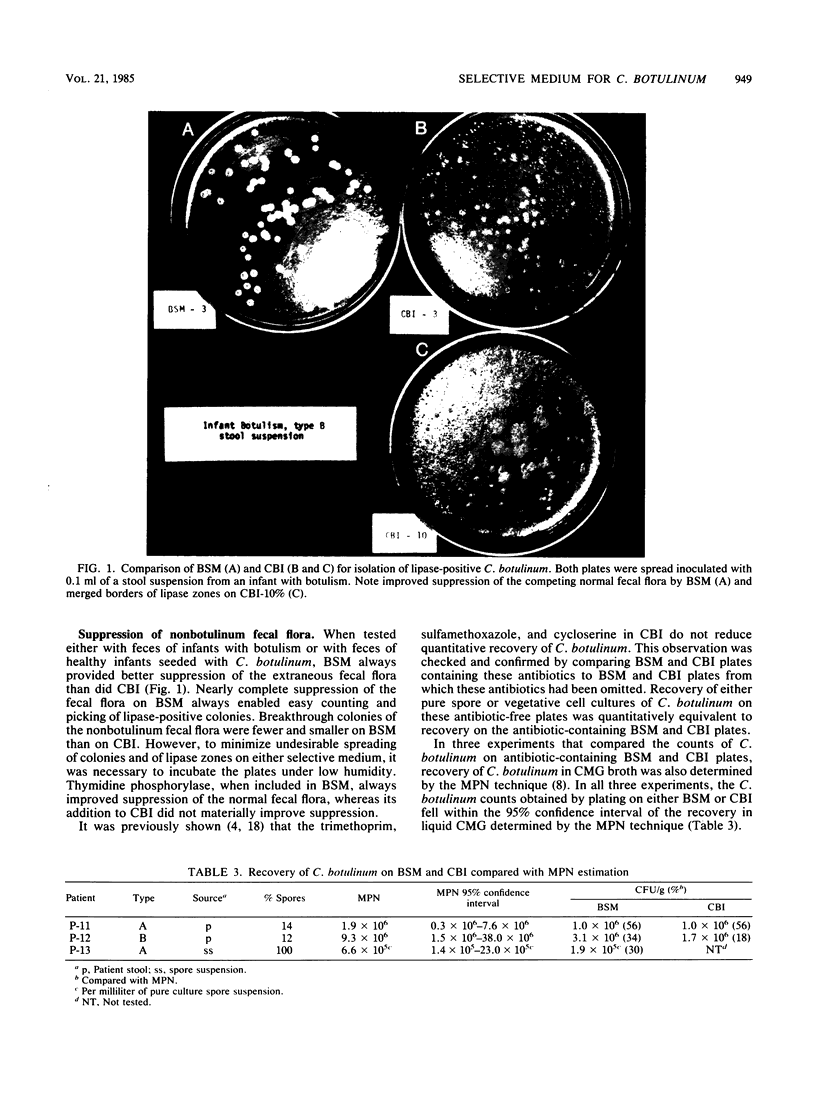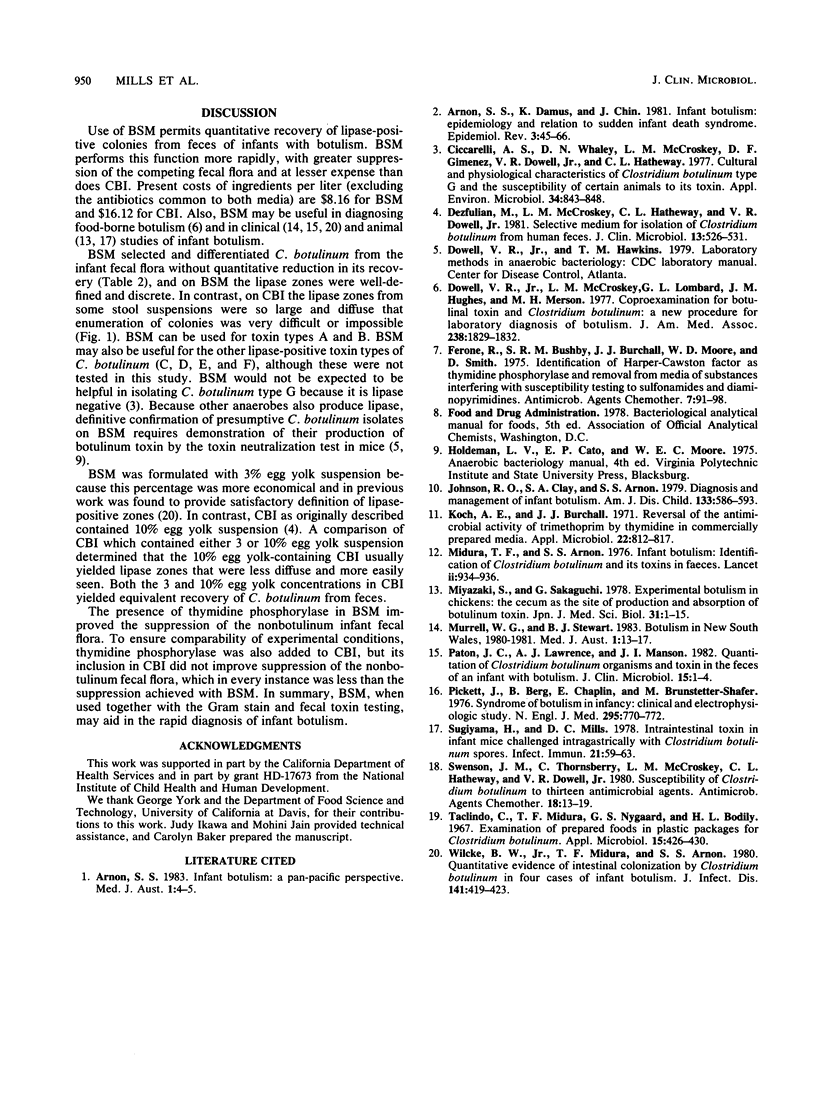Abstract
Isolation of lipase-positive Clostridium botulinum from fecal specimens establishes the diagnosis of infant botulism, contributes to the diagnosis of food-borne botulism, and is most easily accomplished by use of selective media. Modification of an available selective medium, C. botulinum inhibitory medium (CBI), enabled more rapid isolation of C. botulinum. The modified medium (botulinum selective medium [BSM] contained (per liter) 25 g of dehydrated heart infusion broth, 20 g of agar, 30 ml of egg yolk suspension, 250 mg of cycloserine, 76 mg of sulfamethoxazole, 4 mg of trimethoprim, and 100 IU of thymidine phosphorylase at pH 7.4. The two media were compared by using 15 fresh fecal specimens from infant botulism patients (10 type A and 5 type B) and a C. botulinum isolate that had been obtained from an infant botulism patient and that was mixed into a fresh stool specimen from a healthy human infant. In comparison to CBI, BSM always provided better suppression of the nonbotulinum fecal flora and earlier emergence of lipase-positive colonies. Diagnosis of infant botulism was accomplished sooner with BSM than with CBI because isolation of lipase-positive C. botulinum was easier.
Full text
PDF



Images in this article
Selected References
These references are in PubMed. This may not be the complete list of references from this article.
- Arnon S. S., Damus K., Chin J. Infant botulism: epidemiology and relation to sudden infant death syndrome. Epidemiol Rev. 1981;3:45–66. doi: 10.1093/oxfordjournals.epirev.a036239. [DOI] [PubMed] [Google Scholar]
- Arnon S. S. Infant botulism. A Pan-Pacific perspective. Med J Aust. 1983 Jan 8;1(1):4–5. doi: 10.5694/j.1326-5377.1983.tb135999.x. [DOI] [PubMed] [Google Scholar]
- Ciccarelli A. S., Whaley D. N., McCroskey L. M., Gimenez D. F., Dowell V. R., Jr, Hatheway C. L. Cultural and physiological characteristics of Clostridium botulinum type G and the susceptibility of certain animals to its toxin. Appl Environ Microbiol. 1977 Dec;34(6):843–848. doi: 10.1128/aem.34.6.843-848.1977. [DOI] [PMC free article] [PubMed] [Google Scholar]
- Dezfulian M., McCroskey L. M., Hatheway C. L., Dowell V. R., Jr Selective medium for isolation of Clostridium botulinum from human feces. J Clin Microbiol. 1981 Mar;13(3):526–531. doi: 10.1128/jcm.13.3.526-531.1981. [DOI] [PMC free article] [PubMed] [Google Scholar]
- Dowell V. R., Jr, McCroskey L. M., Hatheway C. L., Lombard G. L., Hughes J. M., Merson M. H. Coproexamination for botulinal toxin and clostridium botulinum. A new procedure for laboratory diagnosis of botulism. JAMA. 1977 Oct 24;238(17):1829–1832. [PubMed] [Google Scholar]
- Ferone R., Bushby S. R., Burchall J. J., Moore W. D., Smith D. Identification of Harper-Cawston factor as thymidine phosphorylase and removal from media of substances interfering with susceptibility testing to sulfonamides and diaminopyrimidines. Antimicrob Agents Chemother. 1975 Jan;7(1):91–98. doi: 10.1128/aac.7.1.91. [DOI] [PMC free article] [PubMed] [Google Scholar]
- Johnson R. O., Clay S. A., Arnon S. S. Diagnosis and management of infant botulism. Am J Dis Child. 1979 Jun;133(6):586–593. doi: 10.1001/archpedi.1979.02130060026004. [DOI] [PubMed] [Google Scholar]
- Koch A. E., Burchall J. J. Reversal of the antimicrobial activity of trimethoprim by thymidine in commercially prepared media. Appl Microbiol. 1971 Nov;22(5):812–817. doi: 10.1128/am.22.5.812-817.1971. [DOI] [PMC free article] [PubMed] [Google Scholar]
- Midura T. F., Arnon S. S. Infant botulism. Identification of Clostridium botulinum and its toxins in faeces. Lancet. 1976 Oct 30;2(7992):934–936. doi: 10.1016/s0140-6736(76)90894-1. [DOI] [PubMed] [Google Scholar]
- Miyazaki S., Sakaguchi G. Experimental botulism in chickens: the cecum as the site of production and absorption of botulinum toxin. Jpn J Med Sci Biol. 1978 Feb;31(1):1–15. doi: 10.7883/yoken1952.31.1. [DOI] [PubMed] [Google Scholar]
- Murrell W. G., Stewart B. J. Botulism in New South Wales, 1980-1981. Med J Aust. 1983 Jan 8;1(1):13–17. doi: 10.5694/j.1326-5377.1983.tb136015.x. [DOI] [PubMed] [Google Scholar]
- Paton J. C., Lawrence A. J., Manson J. I. Quantitation of Clostridium botulinum organisms and toxin in the feces of an infant with botulism. J Clin Microbiol. 1982 Jan;15(1):1–4. doi: 10.1128/jcm.15.1.1-4.1982. [DOI] [PMC free article] [PubMed] [Google Scholar]
- Pickett J., Berg B., Chaplin E., Brunstetter-Shafer M. A. Syndrome of botulism in infancy: clinical and electrophysiologic study. N Engl J Med. 1976 Sep 30;295(14):770–772. doi: 10.1056/NEJM197609302951407. [DOI] [PubMed] [Google Scholar]
- Sugiyama H., Mills D. C. Intraintestinal toxin in infant mice challenged intragastrically with Clostridium botulinum spores. Infect Immun. 1978 Jul;21(1):59–63. doi: 10.1128/iai.21.1.59-63.1978. [DOI] [PMC free article] [PubMed] [Google Scholar]
- Swenson J. M., Thornsberry C., McCroskey L. M., Hatheway C. L., Dowell V. R., Jr Susceptibility of Clostridium botulinum to thirteen antimicrobial agents. Antimicrob Agents Chemother. 1980 Jul;18(1):13–19. doi: 10.1128/aac.18.1.13. [DOI] [PMC free article] [PubMed] [Google Scholar]
- Taclindo C., Jr, Nygaard G. S., Bodily H. L. Examination of prepared foods in plastic packages for Clostridium botulinum. Appl Microbiol. 1967 Mar;15(2):426–430. doi: 10.1128/am.15.2.426-430.1967. [DOI] [PMC free article] [PubMed] [Google Scholar]
- Wilcke B. W., Jr, Midura T. F., Arnon S. S. Quantitative evidence of intestinal colonization by Clostridium botulinum in four cases of infant botulism. J Infect Dis. 1980 Apr;141(4):419–423. doi: 10.1093/infdis/141.4.419. [DOI] [PubMed] [Google Scholar]



